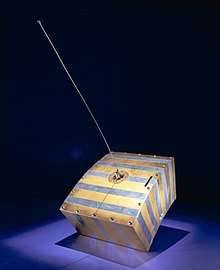UoSAT-1
UoSAT-1, also known as UoSAT-OSCAR 9 (UO-9), was a British amateur radio satellite which orbited Earth. It was built at the University of Surrey and launched into low Earth orbit on 6 October 1981. It exceeded its anticipated two-year orbital lifespan[1] by six years, having received signals on 13 October 1989,[2] before re-entering the atmosphere.
| Mission type | OSCAR |
|---|---|
| Operator | University of Surrey |
| COSPAR ID | 1981-100B |
| SATCAT no. | 12888 |
| Spacecraft properties | |
| Launch mass | 54 kilograms (119 lb) |
| Start of mission | |
| Launch date | 6 October 1981, 11:27 UTC |
| Rocket | Delta 2310 D-157 |
| Launch site | Vandenberg SLC-2W |
| Orbital parameters | |
| Reference system | Geocentric |
| Regime | Low Earth |
| Perigee altitude | 372 kilometres (231 mi) |
| Apogee altitude | 374 kilometres (232 mi) |
| Inclination | 97.6° |
| Period | 92 minutes |
This was the first of several UoSAT satellites; followed by UoSAT-2.
Mission
Like its successor UoSAT-2 it carried a CCD camera and a Digitalker speech synthesiser,[1] and transmitted telemetry data on a 145.826 MHz beacon at 1200 baud using asynchronous AFSK.[3]
The Astrid package sold by British firm MM Microwave,[4] consisting of a fixed frequency VHF receiver set and software for the BBC Micro, could display the telemetry frames from either UoSAT-1 or UoSAT-2.[1] UoSAT-1's solar arrays were of an experimental design reused for UoSAT-2.[1]
Computers and Data Processing
The primary computer for the satellite was the RCA 1802 microprocessor.[5] A secondary microprocessor was also employed, the "F100L" (a Ferranti 16-bit processor). Memory was 16K of DRAM.
References
- Cook, Mike (June 1986). "Way into the world of satellite telemetry: Mike Cook reviews the Astrid telemetry package". The Micro User. Stockport, UK: Database Publications. 4 (4): 100–1. ISSN 0265-4040.
- Bopp, Matthias (2 October 2010). "Homepage DD1US / Sounds from Space". Retrieved 13 October 2010.
- "Amateur Satellite Summary - UoSAT-OSCAR-11". AMSAT. AMSAT. Retrieved 17 January 2014.
- Webb, Stephen R. (16 January 2008). "Even More FAQs". Archived from the original on 2 August 2009. Retrieved 13 October 2010.
- "The COSMAC 1802 and AMSATs, OSCARs and UoSATs".
